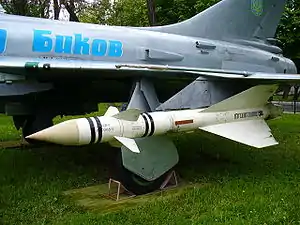K-8 (missile)
The Kaliningrad K-8 (R-8) (NATO reporting name AA-3 'Anab') was a medium-range air-to-air missile developed by the Soviet Union for interceptor aircraft use.[1]
| K-8 AA-3 Anab | |
|---|---|
 | |
| Type | Medium-range air-to-air missile |
| Place of origin | Soviet Union |
| Service history | |
| In service | ~1960-1992 |
| Used by | Soviet Air Forces |
| Production history | |
| Designer | Matus Bisnovat |
| Manufacturer | Kaliningrad Series Production Plant |
| Specifications (R-98MR) | |
| Mass | 292 kg (644 lb) |
| Length | 4.3 m (14 ft) |
| Diameter | 280 mm (11 in) |
| Warhead | Blast fragmentation |
| Warhead weight | 40 kg (88 lb) |
| Engine | Solid-fuel rocket |
Operational range | 23 kilometres (14 mi) |
| Maximum speed | Mach 2 |
Guidance system | Semi-active radar homing (R-98MR) Infrared homing (R-98MT) |
Launch platform | Su-11, Su-15, Yak-28P |
The missile was developed by OKB-339/NII-339 (currently Phazotron NIIR). The infrared seeker was developed by TsKB-589 GKOT (currently TsKB Geofizika), who also developed the seeker for 9M31 missile of 9K31 Strela-1.[1]
History
The K-8's development began in 1955, known as R-8 in service. Like most Soviet air-to-air missiles, it was made with a choice of semi-active radar homing or infrared seeker heads. The original missile was compatible with the Uragan-5B radar used on the Sukhoi Su-11 and several developmental aircraft from Mikoyan-Gurevich.[1]
It was upgraded to R-8M (better known as R-98) standard in 1961, giving the SARH weapon the capability for head-on intercepts. In 1963 it was further upgraded to the R-8M1, making it compatible with the RP-11 Oriol-D radar of the Sukhoi Su-15 and Yakovlev Yak-28P.[1]
Subsequent development led in 1965 to R-8M2, more commonly called R-98, with longer range and improved seekers, compatible with the upgraded RP-11 Oryol-M ("Eagle") radar. The final variant, introduced from 1973, was the R-98M1 (NATO 'Advanced Anab') with better countermeasures resistance and longer range, matched to the Taifun-M radar of the Su-15TM and Yak-28PM interceptors.[1]
The R-98M1 remained in service through the 1980s, being withdrawn with the last Su-15 'Flagon' interceptors.[1]
A variant using the seeker heads of the K-13, giving better dogfight capability, was developed in 1960 as the K-88, but it did not enter service.[1]
An inert training version was also developed, designated UR-8M.[1]
The R-98 brought down Korean Air Lines Flight 007 on September 1, 1983.
Operators
Specifications (R-98MT / R-98MR)

- Length: (R-98MT) 4 m (13 ft 1 in); (R-98MR) 4.27 m (14 ft)
- Wingspan: 1300 mm (4 ft 3 in)
- Diameter: 280 mm (11 in)
- Launch weight: (R-98MT) 272 kg (600 lb); (R-98MR) 292 kg (642 lb)
- Speed: Mach 2
- Range: 23 km (14.4 mi)
- Guidance: (R-98MT) infrared homing; (R-98MR) semi-active radar homing
- Warhead: 40 kg (88 lb) blast fragmentation
References
- Citations
- Gordon, Yefim. Soviet/Russian Aircraft Weapons. Midland. 2004. ISBN 1-85780-188-1
- Bibliography
- Gordon, Yefim (2004). Soviet/Russian Aircraft Weapons Since World War Two. Hinckley, England: Midland Publishing. ISBN 1-85780-188-1.
External links
| Wikimedia Commons has media related to Kaliningrad R-8. |